Contents
Bulgarian pepper Gogoshary love for the original shape and piquant taste. And high productivity and good transportability make it expedient to grow this crop not only in the household, but also on an industrial scale.

The fruits of the Gogoshary variety are large and fleshy.
The story of
The originator of the variety was the Moldavian Research Institute of Vegetable Growing. Later, breeders decided to unite under one name a group of varieties that have external similarities. In the course of the work, scientists tried to give Gogoshary Bulgarian pepper a piquant taste and provide good immunity to diseases and pests.
Description of Gogoshary pepper
The external description of the sweet pepper Gogoshary, as seen in the photo, has some differences from other varieties of culture. It is a perennial subshrub of the Solanaceae family, which is usually grown as an annual plant.
Pepper bushes are compact, upright. The height of branching tetrahedral stems is on average 35-45 cm. The crown diameter is about 50 cm. Herbaceous shoots, extremely fragile at the seedling stage, become strong and woody at the base by the time of fruiting.
Saturated green petiolate leaves have a rounded-elongated shape with a sharp tip. The leafiness of the stems is moderate.
During the flowering period, the plant is covered with white single flowers, in place of which the ovary is later formed.
The rounded flattened ribbed fruits of Gogoshary bell pepper, as seen in the photo, outwardly resemble small pumpkins. These are false multi-seeded hollow berries, consisting of a pericarp (pulp) and an overgrown placenta (carpel area) with seeds.
The color of peppers in most cases is red, but there are varieties with fruits of yellow, orange, brown and even purple hues. The weight of peppers, depending on the type, can also be different and varies between 60-220 g.
The pulp is dense, juicy, crunchy. The walls are thick – from 0,5 to 1 cm. The taste is pleasant, sweetish, sometimes with a spicy bitterness. A characteristic feature of the variety is the ability of the fruit to ripen after being removed from the bush.
The flat, rounded seeds are slightly curved and light yellow in color. Germination is maintained for 2-3 years.
The root system of Gogoshary pepper is branched, the central root can go into the soil to a depth of 40 to 100 cm. Most of the lateral roots are located close to the soil surface.
Gogoshar peppers are distinguished by good keeping quality and the ability to withstand transportation over long distances.
Vitamin-rich fruits are used for cooking various dishes and preservation.
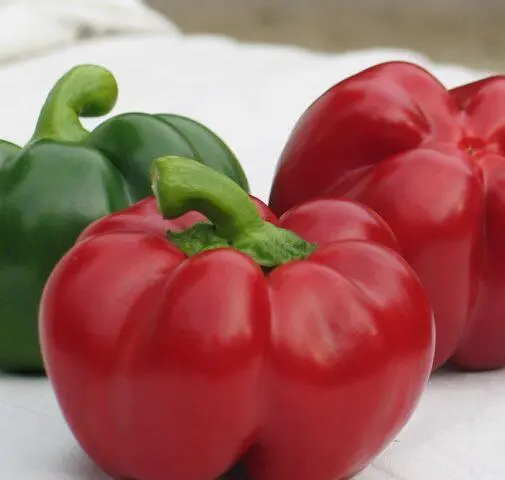
Gogoshary pepper can also be consumed fresh
Characteristics of Gogoshary pepper
Like all representatives of a culture that arrived in European countries from the tropics, Gogoshary pepper loves warmth and moisture. A decrease in air temperature during the growing season and fruiting below +16 ° C can be fatal for him. Under the influence of cold, the shoots stop growing, the leaves turn white, and the flowers and the ovary that has already formed fall off.
The culture is characterized as self-pollinating. Moreover, flowers often pollinate not only their own bush, but also neighboring plants, which can affect the taste of fruits. That is why, when growing several varieties of pepper in one area, in order to prevent cross-pollination, it is necessary to place them at a great distance from each other.
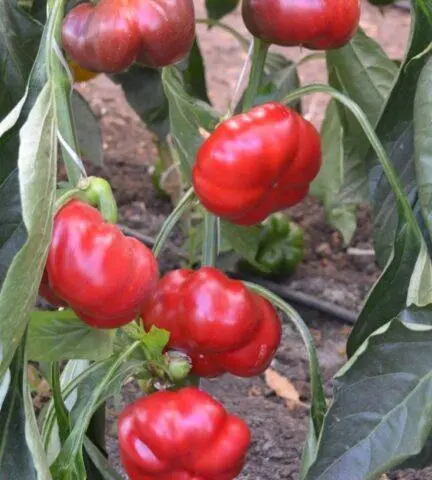
About a dozen peppers can ripen on one bush
The yield of Gogoshary pepper
Moldovan pepper Gogoshary is a mid-season variety, the fruiting period of which begins about 110 days after the seeds hit the soil and continues until the very cold. The crop yield is characterized as high. Under favorable weather conditions and proper agricultural practices from 1 square. m you can collect about 10 kg of ripe large fruits.
Disease resistance
Gogoshary pepper is resistant to many diseases characteristic of this crop. However, violation of the rules of cultivation causes a fungal infection. In addition, it is often the object of attack by harmful insects.
Growing regions
The variety was recommended for cultivation in the warm regions of Moldova, the Federation, Ukraine, and also Romania. In areas with a temperate and cool climate, Gogoshary pepper is grown in greenhouses.
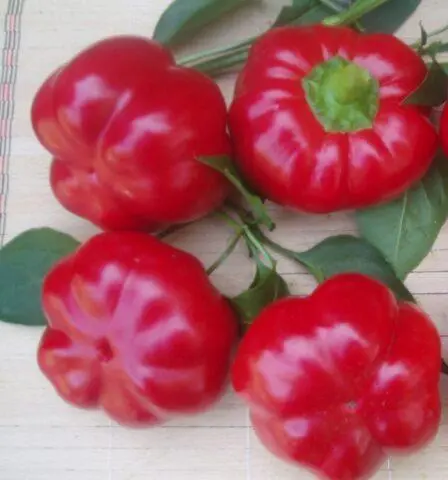
Gogoshary peppers are not only tasty, but also beautiful
Varieties
There are several types of Gogoshary pepper, differing from each other in color and taste. This diversity allows you to choose a culture based on your own preferences.
Ratuna
A classic representative of the variety with bright red ribbed fruits. The average weight of moderately hot Gogoshary pepper is about 120 g, the fruit walls are not very thick (about 5 mm), the taste is sweetish with spicy notes.
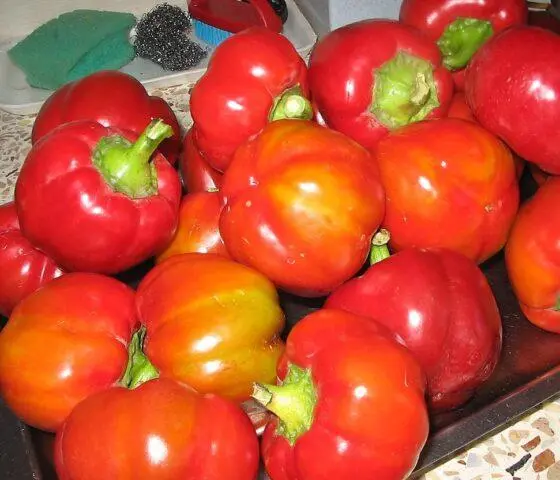
Light bitterness does not spoil the taste of Ratunda
Ruby
Rounded ribbed fruits of this pepper are painted in dark red or brown. One of the advantages of the species is its wall thickness (about 1 cm). The weight of pepper varies between 100-150 g, the taste is pleasant, slightly bitter.

The yield of the Ruby species is rated as high
Gingerbread Man
Unlike other representatives of the Gogoshary variety, this pepper has a round shape without ribs. Green at the stage of milky maturity, by the time of final maturation, the Gingerbread Man acquires a beautiful red-orange hue. The compact size and convenient shape allow this pepper to be used for whole-fruit canning.
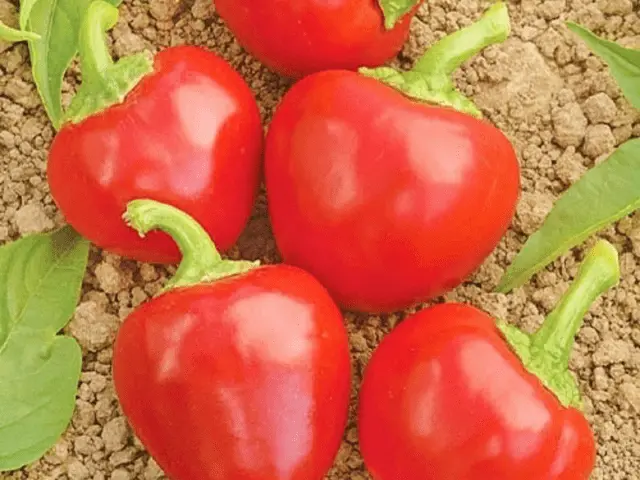
The taste of the fruits of the Kolobok variety is sweet without bitterness
Olenka
A high-yielding species that allows you to collect up to 9 kg of peppers from 1 square. m. Intense red fruits at the stage of full maturity have a flat-round ribbed shape characteristic of all representatives of the Gogoshary variety and a pleasant spicy taste.
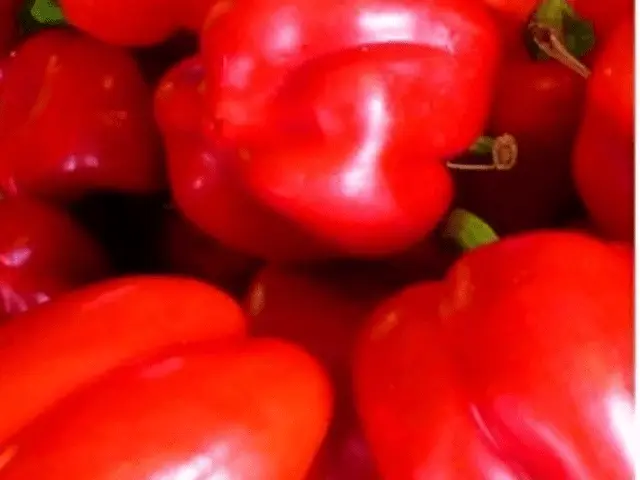
The skin of Olenka fruits is glossy strong
Sweetie
The dark red fruits of this species are wide at the base and pointed downwards. The peppers themselves are small (about 60 g), but thick-walled and sweet.

Candy is one of the smallest species of this variety.
Fragrant Golden Jubilee
Yellow pepper Gogoshary with sweet juicy pulp. The shape of the fruit of this species is round, with slightly pronounced ribbing. The vegetables themselves are large – about 200 g each.
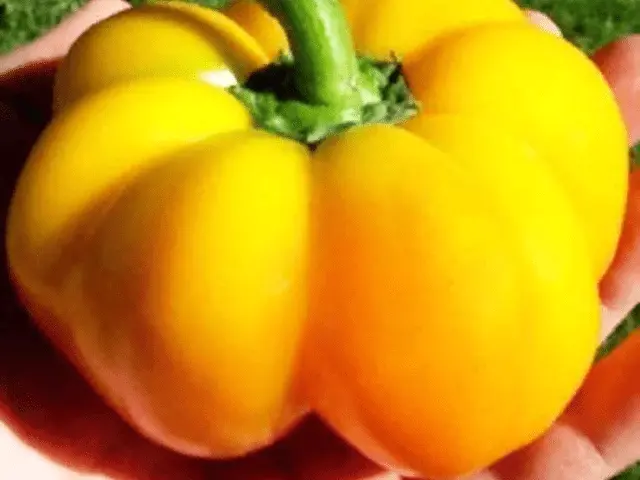
Pepper flavor Fragrant has no bitter notes
Golden Tamara
High-yielding species with juicy sweet pulp. The thickness of the walls of the Golden Tamara is more than 1 cm, and the weight of one fruit reaches 220 g.

Golden Tamara – the thickest-walled type of Gogoshary variety
Advantages and disadvantages
Gogoshary pepper has a pleasant spicy fruit taste and high yield.
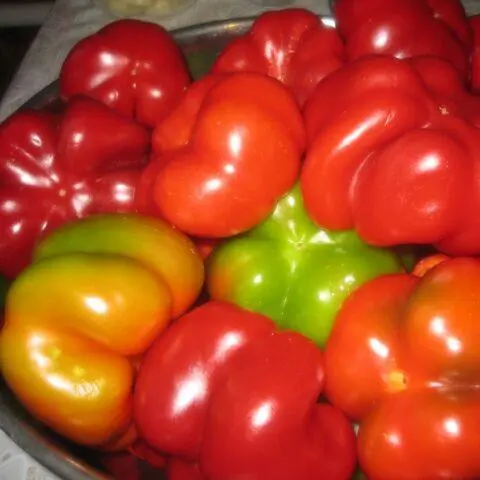
After being removed from the bush, the fruits remain fresh for two months.
Pros:
- compactness of bushes and fruits;
- excellent presentation;
- extended period of fruiting;
- versatility of use;
- good transportability;
- low calorie content and high content of vitamins;
- the ability to ripen after being removed from the bush.
Cons
- low cold resistance and drought resistance;
- poor survival after damage to the root system;
- insufficiently good immunity to pests.
Features of growing Gogoshary pepper
Sweet and semi-hot pepper Gogoshary can hardly be called unpretentious. Therefore, in order to ensure the normal development of the crop and get a good harvest, you need to know the rules for its cultivation.
When and how to plant Gogoshary pepper for seedlings
Pepper is planted in open ground approximately 60 days after the seeds hit the ground. This should be taken into account when determining the timing of planting seeds for seedlings (end of February, beginning of March).
Ideally, plant peppers in individual glasses. If this is not possible, you can use a large shared container for this. In this case, special care will have to be taken when transplanting plants, because this culture painfully tolerates damage to the central root.
The soil used is light fertile. The seeds are buried by 1,5-2 cm and the container is covered with a film to ensure the greenhouse effect. After the emergence of seedlings, the film is removed and appropriate care is provided for the seedlings, including moderate watering and top dressing.
Transplantation in open ground
Seedlings are transferred to open ground when the mercury column of the thermometer is stable at +16 ° C and the threat of return frosts has passed.
Seedlings are planted in pre-prepared and moistened holes at a distance of 25 cm. There should be at least 60 cm between rows.
Further Care
The subsequent care of seedlings is:
- watering as the soil dries;
- regular top dressing with superphosphates and organic fertilizers;
- loosening the soil and removing weeds;
- hilling seedlings.
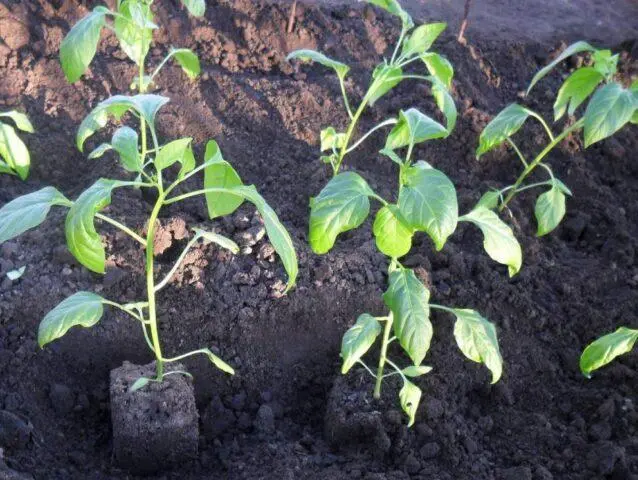
Planting seedlings with root ball of soil
Disease and Pest Prevention
The cause of the development of fungal diseases – spotted wilt, mosaic, black leg, late blight – can be:
- excessive soil moisture;
- nutritional deficiency;
- density of landings;
- lack of preventive measures.
Help prevent trouble:
- organization of proper watering and fertilizing;
- planting plants at optimal intervals;
- removing weeds and loosening the soil;
- periodic inspection of plants for diseases and removal of diseased specimens from the garden;
- treatment of diseases and preventive treatment of plantings with fungicidal preparations.
Bulgarian pepper Gogoshary often becomes the object of attack by harmful insects – aphids, spider mites and slugs. To get rid of the first two, insecticides such as Actellik, Aktara, Karbofos are used. You can drive slugs out of the garden by sprinkling lime or mustard powder between the rows.
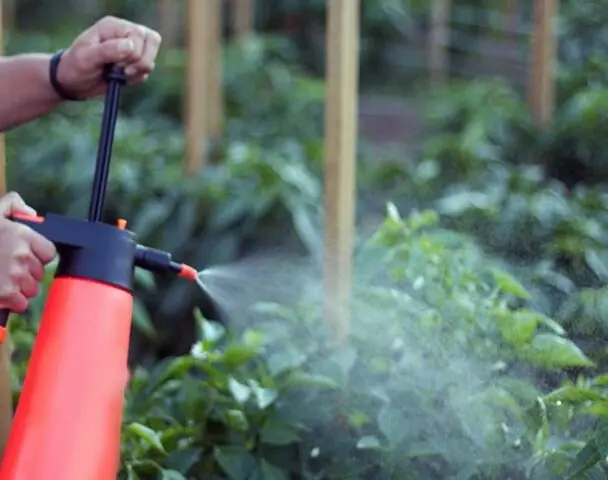
It is recommended to process landings with a sprayer.
Conclusion
Gogoshary pepper is a demanding culture. However, with the right agricultural technology, you can provide your family with a good harvest of large, sweet and vitamin-rich vegetables.









